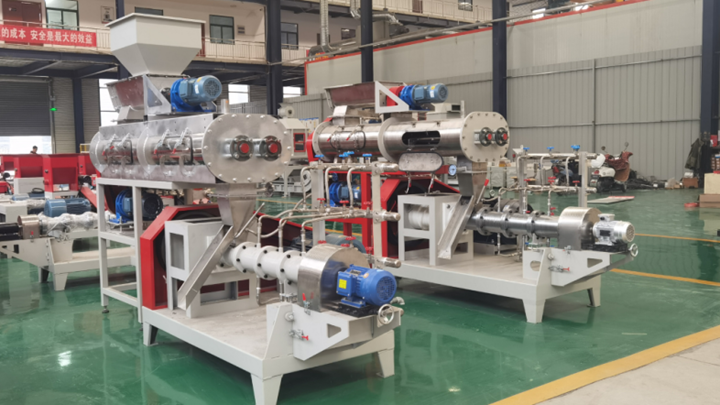
Floating fish feed machines are also known as fish feed extruders and play a crucial role in the production of high-quality floating fish feed for aquaculture operations. The extruder uses extrusion to form floating pellets, which involves conditioning, gelatinizing, and expanding the feed mixture.

Whether you’re looking for a floating pellet extruder machines or exploring options from China floating fish feed making machine suppliers, understanding your needs and the market is crucial. This guide will help you navigate the diverse options available, focusing on price, suppliers, and regional availability.

The floating fish feed machine is to convert soybean meal, rice bran, fish meal, bone meal, corn meal, flour, etc. into fish feed pellets with various shapes by heating and extruding. It has a capacity of 40-350kg/h, even bigger.

The shape of fish feed are pellets, granule and tablet. 2. How to make floating fish feed? Fish food is made by extruding the mixed material through the holes on a metal mould. Basically, there are two type of machines for fish food production: Ring die pellet mill and twin screw extruder:

Floating Fish Feed in Kolkata, West Bengal - IndiaMARTlow price Hake fish feed pellet machine kolkata-floating fish feed Fish Feed Pellet Making Machine, Pellet Mills, Feed Pell +8619337889051 lima37@limamachinery.com
.jpg)
We are a professional manufacturer focusing on manufacturing of fish feed pellet machine. Our floating fish feed pellet mill production capacity covers 40kg to 1000kg per hour. In addition to stand-alone machines, we are also good at designing and integrating complete fish food production lines with flexible configurations.
.jpg)
Factors Shaping the Floating Fish Feed Making Machine Price in Nigeria. If you’re grappling with the varying floating fish feed making machine prices in Nigeria, here are some factors to consider: Machine Capacity: floating fish feed machine in Nigeria designed for expansive commercial setups come at a premium.
.jpg)
Animal Feed Pelleting - CPMAnimal Feed Pelleting - CPMPet Food Processing Plant Manufacturing Dog Food And Cat It can produce all kinds of feed and food, such as aquatic feed, +8619337889075 lima38@limamachinery.com

We offer all kinds of fish feed pellet machines including floating fish feed pellet machine and sinking feed pellet machine. Small Pet Food & Aquatic Feed Pellet Plant (100~150kg/h) 1. Crushing Machine 2. baghouse system 3. Mixing Machine 4. Feed Extruder 5. Air Conveyor 6. Belt Dryer 7. Coating Machine

Maintenance Tips for Floating Fish Feed Extruder Machine. Regular Cleaning: Over time, remnants of feed can stick to the fish feed making machine.Regular cleaning ensures longevity and optimal functioning.

05. The twin-screw floating fish feed extruder machine has many advantages, such as wider adaptability of raw materials, wider adaptability of products, better internal and external quality of products, higher output under the same power, better ripening and homogenizing effect, less wear of vulnerable parts, and lower production cost.

What is Fish Feed Pellet Machine? A fish feed pellet machine is a crucial piece of equipment for any fish farm, converting raw ingredients into nutrient-rich pellets. These pellets come in two types: floating and sinking, catering to the feeding habits of different fish species. video of fish feed extruder machine
.jpg)
Bird food machine; Place of Origin: China; Certififishion: CE, BV, ISO, SGS; Min.Order Quantity: One set ISO Approved Automatic Low density floating and sinking fish feed

Fish Food Extruder, Floating Pellet Machine, Animal Feed Pellet: 1 Set : US$1765: US$6922: Commercial Fish Feed Pellet Machine/Fish Food Pellet Machine/Floating Fish Feed Extruder: 1 Set : US$1548: US$6336: Floating Aqua Feed Pellet Machine, Dog Shape Pet Food Extruder as Extrusion Pellet Machine, One of Main Fish Farm Feed Equipment: 1 Set

1 day ago · The physical feed quality is critical in enabling the feed to provide the desired nutrition and energy to the fish. Some of the common quality issues are feed integrity, non-uniformity of feed sizes, unable to attain the desired level of floatability (in case of floating feeds), dust creation from feeds, oil leakage, rancidity issues, and raw material quality.